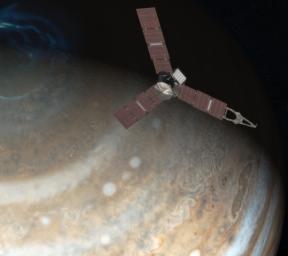
|
Juno Above Jupiter’s Pole (Artist’s Concept)
- Click the image above for a larger view
- Full-Res JPEG (5475 x 4875) (1.9 MB)
- Full-Res TIFF (5475 x 4875) (80.1 MB)
Caption:
This artist's rendering shows NASA's Juno spacecraft above the north pole of Jupiter.
Launched in 2011, the Juno spacecraft will arrive at Jupiter in 2016 to study the giant planet from an elliptical, polar orbit. Juno will repeatedly dive between the planet and its intense belts of charged particle radiation, coming only 5,000 kilometers (about 3,000 miles) from the cloud tops at closest approach.
Background Info:
Juno's primary goal is to improve our understanding of Jupiter's formation and evolution. The spacecraft will spend a little over a year investigating the planet's origins, interior structure, deep atmosphere and magnetosphere. Juno's study of Jupiter will help us to understand the history of our own solar system and provide new insight into how planetary systems form and develop in our galaxy and beyond.
NASA's Jet Propulsion Laboratory, Pasadena, Calif., manages the Juno mission for the principal investigator, Scott Bolton, of Southwest Research Institute in San Antonio. The Juno mission is part of the New Frontiers Program managed at NASA's Marshall Space Flight Center in Huntsville, Ala. Lockheed Martin Space Systems, Denver, built the spacecraft. JPL is a division of the California Institute of Technology in Pasadena.
More information about Juno is online at http://www.nasa.gov/juno and http://missionjuno.swri.edu .
Cataloging Keywords:
| Name | Value | Additional Values |
|---|---|---|
| Target | Jupiter | |
| System | Jupiter | |
| Target Type | Planet | |
| Mission | Juno | |
| Instrument Host | Juno | |
| Host Type | Orbiter | |
| Instrument | ||
| Detector | ||
| Extra Keywords | Artwork, Atmosphere, Color, Magnetosphere | |
| Acquisition Date | ||
| Release Date | 2013-03-11 | |
| Date in Caption | ||
| Image Credit | NASA/JPL-Caltech | |
| Source | photojournal.jpl.nasa.gov/catalog/PIA16869 | |
| Identifier | PIA16869 | |
